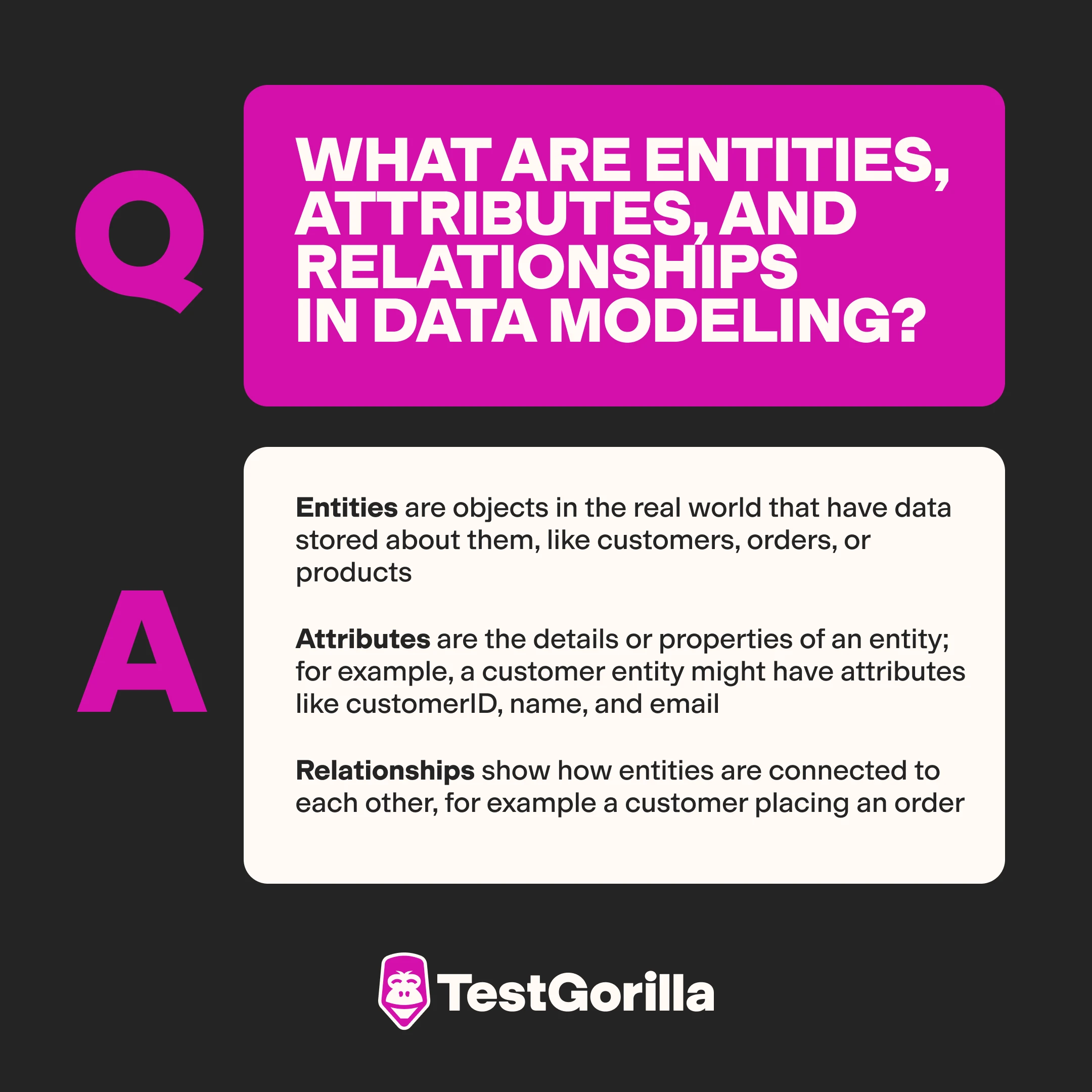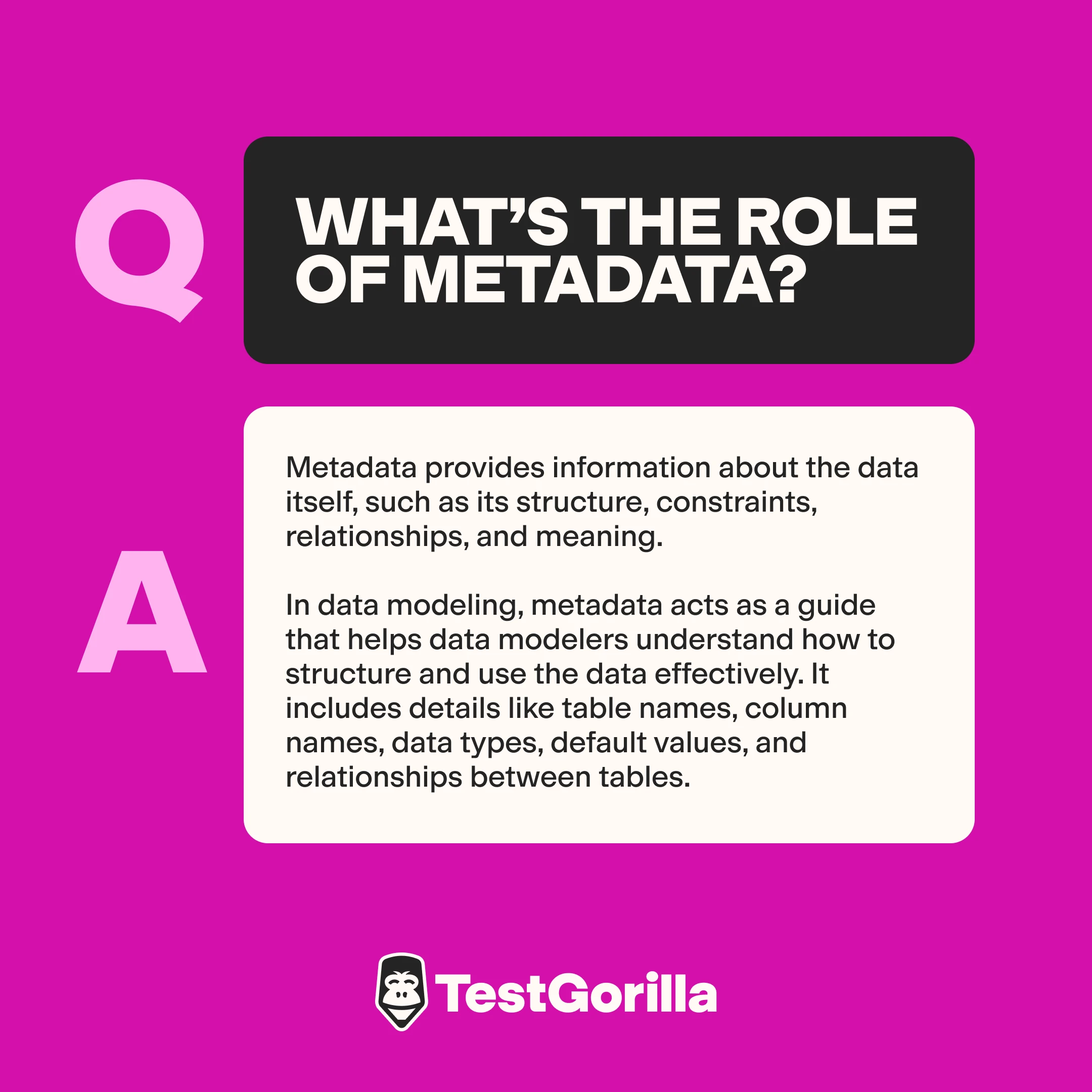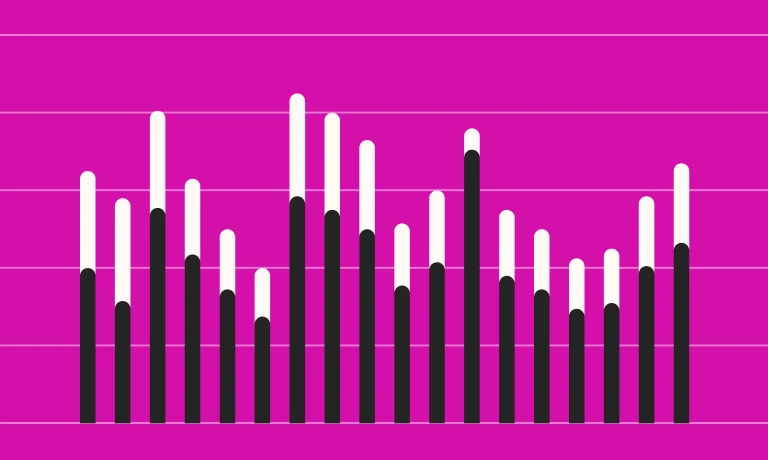50 data modeling interview questions to hire top data experts
Finding the right data modeler or analyst can make a big difference in how well your organization uses its data and whether it manages to stay ahead of the competition.
But what’s the best way to identify top talent in such a new and competitive field?
By using skills tests to assess applicants – and then invite the best ones to an interview, to ask them targeted data modeling interview questions. This skills-based approach to hiring enables you to evaluate candidates fairly and objectively and not waste time interviewing applicants who simply aren’t qualified.
Here are some of the tests you can use to identify top talent when hiring a data analyst, modeler, or engineer:
Working with Data: Identify applicants who know how to handle data to track and present results.
Data Modeling Concepts: Assess candidates’ knowledge and practical skills in modeling data and creating logical, conceptual, and physical models.
MySQL: Make sure candidates know how to manipulate and manage data in relational databases with this test.
NoSQL: Looking for NoSQL experts? This test will help you find them.
As for the interviews, we’ve put together a selection of the best 50 data modeling interview questions to help you prepare. You’ll also find sample answers to 20 of them, helping you review candidates’ responses even if you aren’t a data expert.
20 data modeling interview questions and answers to help assess candidates’ skills
In this section, you’ll find our selection of the best 20 interview questions you can use to evaluate your interviewees’ data modeling skills. We’ve provided sample answers to guide you through the evaluation process, even if you’re not familiar with the key concepts and best practices of data modeling.
1. Can you tell me the difference between a conceptual, logical, and physical data model?
Skilled applicants will explain that:
A conceptual data model gives a high-level overview of the data that's important. It focuses on the big picture and identifies the main entities and their relationships, like a map showing key points without too many details.
A logical data model gets more detailed and defines how the data should be structured. It includes all entities, attributes, and relationships but remains independent of the database technology. It’s similar to the blueprint for a building, showing rooms and connections but not specific materials.
A physical data model is the most detailed, showing exactly how the data will be stored in the database, including table names, column names, data types, and indexes. In this way, it’s similar to a final construction plan with all materials specified.
2. What are entities, attributes, and relationships in data modeling?
Top candidates will explain that:
Entities are objects in the real world that have data stored about them, like customers, orders, or products
Attributes are the details or properties of an entity; for example, a customer entity might have attributes like customerID, name, and email
Relationships show how entities are connected to each other, for example a customer placing an order
3. What is an Entity-Relationship Diagram (ERD)?
An ERD is a visual representation of entities, their attributes, and the relationships between them. It helps see how the data is connected and organized, similarly to a map showing the structure of a database.
4. Can you describe the different normal forms (1NF, 2NF, 3NF, etc.)?
1NF, 2NF, and 3NF are guidelines in database design that help ensure the integrity and efficiency of the database. Top candidates will know that:
First Normal Form (1NF) ensures each column has atomic (indivisible) values and removes repeating groups or arrays
Second Normal Form (2NF) meets all requirements of 1NF and removes partial dependencies, ensuring every non-key attribute depends on the entire primary key
Third Normal Form (3NF) meets all requirements of 2NF and removes transitive dependencies, meaning non-key attributes should depend only on the primary key, not on other non-key attributes
Boyce-Codd Normal Form (BCNF) is a stricter version of 3NF, where every determinant must be a candidate key
5. What is denormalization? When would you use it?
Denormalization is the process of combining tables to reduce the number of joins needed for queries. It can improve read performance by reducing the complexity of database queries.
Data professionals would use it when they need to optimize a database for faster read operations, even if it means sacrificing some storage efficiency and data integrity.
6. Can you explain the difference between a one-to-one, one-to-many, and many-to-many relationship?
Experienced candidates will know that database relationships are crucial for organizing and retrieving data. Here’s an example of the explanations you could expect:
In a one-to-one relationship, each entity in the relationship will have exactly one related entity; for example, a person has one country of residence
In a one-to-many relationship, a single entity is related to multiple entities, such as, for example, a customer placing many orders
In a many-to-many relationship, multiple entities are related to multiple entities; for instance, students can enroll in many courses, and each course can have many students
7. What are composite keys?
Composite keys consist of two or more columns that identify a row in a table. They are useful when a single column isn't enough to ensure uniqueness.
For example, in an enrollment table, a composite key might be (StudentID, CourseID) to ensure each student-course combination is unique.
8. What is a surrogate key? When would you use it?
A surrogate key is a unique identifier for a record in a table, which is not derived from application data. It's often an auto-incremented number.
Expect candidates to explain that they’d use a surrogate key when:
There is no natural key
The natural key is too complex or large
They’re looking to improve performance by simplifying the key structure
For example, instead of using a combination of multiple columns as a primary key, they could use a simple integer as a surrogate key.
9. Can you tell me what's the difference between a star schema and a snowflake schema?
Look for answers that clearly explain the difference between the two:
A star schema is a type of database schema that is used in data warehousing. It has a central fact table that references multiple dimension tables, forming a star-like pattern. It's simple and efficient for querying.
A snowflake schema is a more complex version where dimension tables are normalized into multiple related tables, forming a snowflake-like structure. This reduces data redundancy but can make querying more complex and slower compared to a star schema.
10. What is a data dictionary?
A data dictionary is a centralized repository of information about the data, such as meaning, relationships to other data, origin, usage, and format. It includes metadata, which is data about the data.
A data dictionary helps in understanding the structure, constraints, and relationships within the database, making it easier for developers and analysts to make sense of the data.
For a deeper evaluation of candidates’ ability to handle complex data, use our Working with Data test.
11. How do you design a data model for a high-performance database?
Here, candidates should outline a process that includes the following steps:
Analyze the requirements and the type of queries that will be run most frequently
Normalize the data to reduce redundancy but consider denormalization for read-heavy applications to speed up queries
Use appropriate indexing to improve query performance
Partition large tables to manage and access data more efficiently
Optimize the use of keys and constraints to maintain data integrity without compromising performance
Monitor and regularly tune the database based on actual usage patterns
12. How do you manage version control for data models?
Managing version control for data models involves using version control systems (VCS) like Git, where each change to the data model is documented with commit messages describing the modifications. Branching and merging strategies enable multiple versions and parallel development.
Looking to evaluate proficiency with Git? We have a Git test that’s designed to do exactly that.
13. How do you ensure data security and privacy in your data models?
To build secure databases, data experts need to:
Implement strong access controls, ensuring that only authorized users can access sensitive data
Use encryption for data at rest and in transit
Mask or anonymize sensitive data as necessary
Implement auditing to track access and changes to the data
Follow compliance requirements and industry standards like GDPR or HIPAA
Regularly review and update security policies
You can use our GDPR and HIPAA tests to evaluate applicants’ knowledge of these two security standards.
14. Can you explain the difference between structured, semi-structured, and unstructured data?
Look for answers that include the following information:
Structured data is highly organized and formatted so it's easily searchable in relational databases. Examples include SQL databases with tables, rows, and columns.
Semi-structured data doesn't conform to a rigid structure but has some organizational properties, making it easier to analyze than unstructured data. Examples include JSON, XML, and email.
Unstructured data lacks a predefined format, making it more challenging to collect, process, and analyze. Examples include text documents, videos, and social media posts.
15. What’s the role of metadata?
Metadata provides information about the data itself, such as its structure, constraints, relationships, and meaning.
In data modeling, metadata acts as a guide that helps data modelers understand how to structure and use the data effectively. It includes details like table names, column names, data types, default values, and relationships between tables.
16. Can you explain the role of data modeling in data warehousing?
Data modeling helps design the structure of the data warehouse, ensuring that the data’s organization supports efficient querying and reporting.
Data models define how to integrate, store, and access data from various models. This includes creating star or snowflake schemas to optimize the data for analytical queries.
17. How do you approach data modeling for NoSQL databases?
Data modeling for NoSQL databases starts with understanding the specific use case and access patterns. Unlike relational databases, NoSQL databases often favor denormalization and schema flexibility. This means that candidates would identify the key entities and their relationships, but focus on how data will be queried and updated.
To further evaluate candidates’ proficiency to manage large-scale databases, use our NoSQL test.
18. How would you model a customer relationship management (CRM) system?
To model a CRM system, data modelers would need to identify:
The core entities, such as customers, leads, orders, account managers, and more
Their attributes, such as customer ID, contact information, and status
Their relationships, such as customers making an order, account managers contacting customers, and so on
Then, they’d need to use foreign keys to maintain these relationships and ensure referential integrity and include indices on frequently queried columns to boost the CRM’s performance.
19. How do you handle conflicting requirements from different stakeholders?
Experienced candidates would guide you through a process that looks something like this:
Talk to all stakeholders to understand their perspectives and concerns
Document each requirement clearly
Prioritize requirements based on business goals and impact
Use data-modeling tools to create different scenarios and demonstrate the implications of each option
Seek compromises where possible, and ensure that everyone shares a common vision
Involve a neutral party (such as a project manager) to help set the overall direction
20. How do you ensure that your data model is scalable?
Top candidates would explain that they’d:
Design the data model with flexibility in mind
Normalize the data to reduce redundancy and maintain integrity, but consider strategic denormalization for performance
Use indexing and partitioning to optimize query performance
Choose data types that can accommodate growth
Regularly review and update the model based on usage patterns and new requirements
Ensure that the model can support horizontal and vertical scaling as needed
Extra 30 data modeling interview questions to ask applicants
If you need more ideas, check out our 30 additional interview questions to evaluate candidates’ proficiency in data modeling.
For more inspiration, check out our interview questions for data analysts and data engineers.
What is a relational database?
Can you define and give an example of a primary key?
What is a foreign key? How do you use one?
What is normalization? Why is it important?
What is an index and how does it affect database performance?
What is referential integrity?
What are the differences between hierarchical, network, and relational data models?
Can you explain the concept of data integrity and its types?
What's the difference between OLTP and OLAP systems?
What tools have you used for data modeling?
Can you explain the steps involved in creating a logical data model?
How do you handle many-to-many relationships in a relational database?
What are the best practices for naming conventions in data modeling?
How do you handle slowly changing dimensions (SCD)?
How do you model hierarchical data in a relational database?
Can you explain the concept of normalization with an example?
How do you approach modeling time-dependent data, such as historical data?
What is a fact table? What role does it play in data modeling?
What are dimension tables, and how do they relate to fact tables?
What's the difference between a database schema and a database instance?
Can you explain the concept of data redundancy and how to minimize it?
Can you explain the use of UML in data modeling?
Describe a challenging data modeling problem you have faced and how you resolved it. Given a set of business requirements, how would you start the data modeling process?
Can you provide an example of how you optimized a data model for performance?
How do you approach the documentation of your data models?
Describe a situation where you had to refactor an existing data model. What challenges did you face?
How do you gather requirements from business users for data modeling?
How would you handle the integration of data from multiple sources in your data model?
How do you validate your data models?
Can you describe your process for migrating data models from one database system to another?
The best insights on HR and recruitment, delivered to your inbox.
Biweekly updates. No spam. Unsubscribe any time.
Hire top data modelers and analysts with the right hiring process
The future of hiring is here – and resume screening is not a part of it.
Skills-based hiring is more predictive of job performance than resumes according to 89% of employers we surveyed. So, instead of focusing on candidates’ diplomas or past experience, evaluate their actual abilities to solve your data problems. Skills tests and interviews enable you to do exactly that.
By putting skills front and center in your hiring process, you’ll be sure to find the perfect fit for your open role, regardless of whether you’re searching for a data modeler with 10 years of experience or a junior data analyst.
Sign up for a 40-minute live demo to see how you can transform your hiring process with our platform – or create an account to get instant access to our Free forever plan and start building your first talent assessment today.
Related posts
You've scrolled this far
Why not try TestGorilla for free, and see what happens when you put skills first.




















